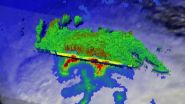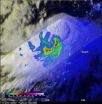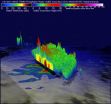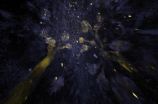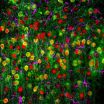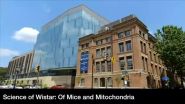(Press-News.org) NASA's Tropical Rainfall Measuring Mission or TRMM Satellite passed over Guam as heavy rain fell over the island while Tropical Storm Halong's center passed just to the north of the island.
The TRMM satellite flew above tropical storm Halong on July 31, 2014 at 0904 UTC (August 1, 2014 at 7:04 p.m. local time, Guam).
At NASA's Goddard Space Flight Center in Greenbelt, Maryland TRMM data was used to create a rainfall analysis. The analysis derived TRMM's Microwave Imager (TMI) and Precipitation Radar (PR) data was overlaid on a visible/infrared image from Japan's MTSAT-2 satellite at 0900 UTC to provide an entire picture of the storm and its rainfall distribution. TRMM PR revealed that rain was falling at a rate of over 85.6 mm (about 3.4 inches) per hour in bands wrapping around Halong's southeastern side.
A simulated 3-D view of Halong (from the northwest) was produced at NASA Goddard using radar reflectivity data from TRMM's Precipitation Radar (PR) instrument. The image showed a slice near the southern edge of the tropical storm's center found thunderstorms reaching heights of over 16.7 km (about 10.4 miles). The release of energy within these intense thunderstorm towers often portends a tropical cyclone's intensification.
On July 30 at 1500 UTC (11 a.m. EDT), Tropical Storm Halong had maximum sustained winds near 50 knots (57.5 mph/92.6 kph). It was centered near 14.9 north latitude and 140.3 east longitude, about 266 nautical miles (306.1 miles/492.8 km) west-northwest of Andersen Air Force Base, Guam. Halong was moving to the west at 8 knots (9.2 mph/14.8 kph). Halong was generating very rough surf with seas up to 22 feet (6.7 meters).
The Joint Typhoon Warning Center is forecasting Halong to continue moving to the west-northwest and to intensify.
VIDEO:
NASA's TRMM Satellite 3-D Flyby of Tropical Storm Halong On July 31, NASA's TRMM Satellite showed rain was falling at a rate of over 85.6 mm (about 3.4 inches) per...
Click here for more information.
INFORMATION:
Text credit: Hal Pierce/Rob Gutro
SSAI/NASA's Goddard Space Flight Center
NASA sees Tropical Storm Halong move northwest of Guam
2014-07-31
ELSE PRESS RELEASES FROM THIS DATE:
Asteroid attacks significantly altered ancient Earth
2014-07-31
TEMPE, Ariz. – New research shows that more than four billion years ago, the surface of Earth was heavily reprocessed – or mixed, buried and melted – as a result of giant asteroid impacts. A new terrestrial bombardment model based on existing lunar and terrestrial data sheds light on the role asteroid bombardments played in the geological evolution of the uppermost layers of the Hadean Earth (approximately 4 to 4.5 billion years ago).
An international team of researchers published their findings in the July 31, 2014 issue of Nature.
"When we look at the present day, ...
Mosaicism: Study clarifies parents as source of new disease mutations
2014-07-31
HOUSTON – (July 31, 2014) – Scientists have long speculated that mosaicism – a biological phenomenon, in which cells within the same person have a different genetic makeup – plays a bigger role in the transmission of rare disease mutations than is currently known. A study conducted by an international team of scientists led by Baylor College of Medicine sheds new light on the frequency of mosaicism in genomic disorders and its influence on recurrence risk.
The study, which was published today in the American Journal of Human Genetics, also included scientists from the ...
In high-stakes soccer, goalkeepers exhibit 'gambler's fallacy'
2014-07-31
When goalkeepers are pitted against multiple kickers in tense penalty shootouts, their attempts to dive for the ball show a predictable pattern that kickers would do well to exploit. After kickers repeatedly kick in one direction, goalkeepers become increasingly likely to dive in the opposite direction, according to an analysis of all 361 kicks from the 37 penalty shootouts that occurred in World Cup and UEFA Euro Cup matches over a 36-year period.
The findings reported in the Cell Press journal Current Biology on July 31 highlight the importance of monitoring and predicting ...
Selective logging takes its toll on mammals, amphibians
2014-07-31
The selective logging of trees in otherwise intact tropical forests can take a serious toll on the number of animal species living there. Mammals and amphibians are particularly sensitive to the effects of high-intensity logging, according to researchers in the Cell Press journal Current Biology on July 31 who conducted a meta-analysis of almost 50 previously published studies from around the world.
"Selective logging in the tropics is not a new phenomenon, and it will continue to be a common use of the forest," says Zuzana Burivalova of ETH Zurich, Switzerland. "We hope ...
See-through organs and bodies will accelerate biomedical discoveries
2014-07-31
The ability to see through organs and even the entire body to visualize long-range connections between cells as well as fine-grained cellular structures has been a long-time dream of biologists. A study published by Cell Press July 31st in the journal Cell has now made that dream a reality, revealing simple methods for making opaque organs, bodies, and human tissue biopsies transparent, while keeping the cellular structures and connections intact. The protocols could pave the way for a better understanding of brain-body interactions, more accurate clinical diagnoses and ...
Goalkeepers prone to 'gambler's fallacy' but penalty takers fail to exploit it
2014-07-31
After a string of penalties aimed in the same direction, goalkeepers are more likely to dive in the opposite direction on the next penalty but kickers fail to exploit this pattern, finds new UCL research.
The study, published in Current Biology, shows that penalty shoot-outs in international tournaments resemble a psychological game. The researchers studied penalty shoot-out videos from all World Cup and Euro finals tournaments between 1976 and 2012.
They found that each team of kickers produced more or less random sequences of kicks to the left or the right of the ...
Birthday matters for wiring-up the brain's vision centers
2014-07-31
Researchers at the University of California, San Diego School of Medicine have evidence suggesting that neurons in the developing brains of mice are guided by a simple but elegant birth order rule that allows them to find and form their proper connections.
The study is published online July 31 in Cell Reports.
"Nothing about brain wiring is haphazard," said senior author Andrew Huberman, PhD, assistant professor in the Department of Neurosciences, Division of Biological Sciences and Department of Ophthalmology, UC San Diego.
A mature, healthy brain has billions ...
New mapping approach lets scientists zoom in and out as the brain processes sound
2014-07-31
Researchers at Johns Hopkins have mapped the sound-processing part of the mouse brain in a way that keeps both the proverbial forest and the trees in view. Their imaging technique allows zooming in and out on views of brain activity within mice, and it enabled the team to watch brain cells light up as mice "called" to each other. The results, which represent a step toward better understanding how our own brains process language, appear online July 31 the journal Neuron.
In the past, researchers often studied sound processing in various animal brains by poking tiny electrodes ...
'Rewired' mice show signs of longer lives with fewer age-related illnesses
2014-07-31
VIDEO:
TRAP-1 is a protein vital for the production of chemical energy in the mitochondria of cells, but it is over-produced in tumor cells. The laboratory of Dr. Dario Altieri at...
Click here for more information.
While developing a new cancer drug, researchers at The Wistar Institute discovered that mice lacking a specific protein live longer lives with fewer age-related illnesses. The mice, which lack the TRAP-1 protein, demonstrated less age related tissue degeneration, ...
Drug target identified for common childhood blood cancer
2014-07-31
In what is believed to be the largest genetic analysis of what triggers and propels progression of tumor growth in a common childhood blood cancer, researchers at NYU Langone Medical Center report that they have identified a possible new drug target for treating the disease.
T-cell acute lymphoblastic leukemia is one of the most common and aggressive childhood blood cancers. An estimated quarter of the 500 adolescents and young adults diagnosed with the cancer each year in the U.S. fail to achieve remission with standard chemotherapy drugs.
In a cover-story report ...
